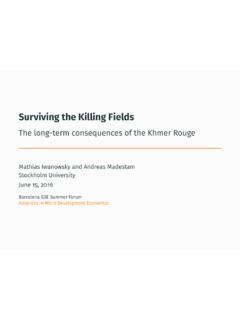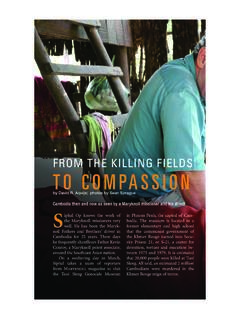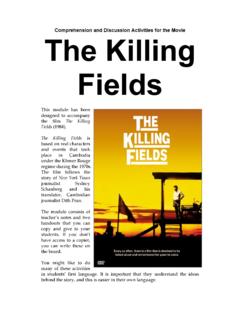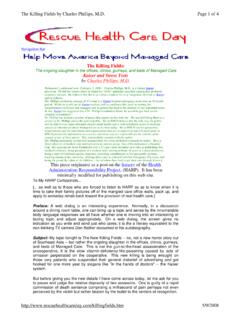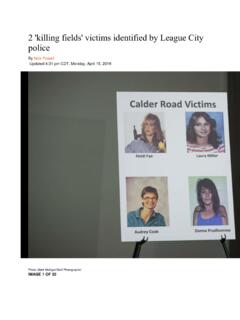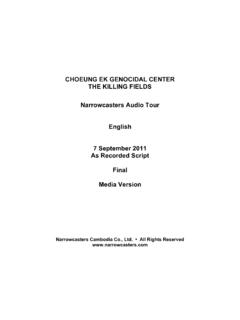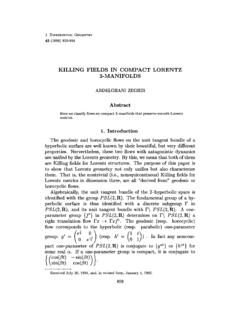Transcription of The Many Colors of Crime - scholar.harvard.edu
1 The many Colors of Crime Inequalities of Race, Ethnicity, and Crime in America E D I T E D BY. Ruth D. Peterson, Lauren I: Krivo, and John Hagan New York University Press NEW YORK AND LONDON. NEW YORK UNIVERSITY PRESS. New York and London O 2006 by New York University All rights reserved Library of Congress Cataloging-in-Publication Data The many Colors of Crime : inequalities of race, ethnicity, and Crime in America / edited by Ruth D. Peterson, Lauren J. Krivo, and John Hagan. p. cm. - (New perspectives in Crime , deviance, and law series). Includes bibliographical references and index. ISBN-13: 978-0-8147-6719-1 (cloth : alk. paper).
2 ISBN-lo: 0-8147-6719-2 (cloth : alk. paper). ISBN-13: 978-0-8147-6720-7 (pbk. : alk. paper). ISBN-lo: 0-8147-6720-6 (pbk. : alk. paper). I. Crime -United States. 2. Discrimination in criminal justice administration-United States. 3. Minorities-United States. I. Peterson, Ruth D. 11. Krivo, Lauren Joy. 111. Hagan, John, 1946- 2006. 2006003g98. New York University Press books are printed on acid-free paper, and their binding materials are chosen for strength and durability. Manufactured in the United States of America c l o g 8 7 6 5 4 3 2 1. ~ 1 0 9 8 7 6 5 4 3 2 1. Chapter I. Cultural Mechanisms and killing Fields A Revised Theory of Community-Level Racial Inequality Robert J.
3 Sampson and Lydia Bean Ten years ago, Sampson and Wilson proposed a theory of race and ur- ban inequality to explain the disproportionate representation of African Americans as victims and offenders in violent Crime .' The basic idea put forth was that community-level patterns of racial inequality give rise to the social isolation and ecological concentration of the truly disadvan- taged, which in turn leads to structural barriers and cultural adaptations that undermine social organization and ultimately the control of Crime . According to this perspective, "race" holds no distinct scientific credibility as a cause of violence-rather, it is a marker for the constellation of so- cial contexts that are differentially allocated by racial status in American society.
4 Sampson and Wilson pursued this logic to argue that the com- munity-level causes of violence are the same for both Whites and Blacks but that racial segregation by community differentially exposes members of minority groups to key violence-inducing and violence-protecting so- cial mechanisms, thereby explaining Black-White disparities in violen~e.~. Their thesis has come to be known as "racial invariance" in the fundamen- tal causes of Crime . In this chapter, we revisit the central arguments of the racial invariance thesis. Our goal is to build on recent findings and articulate new theoreti- cal directions for the study of race, ethnicity, and violence.
5 The good news motivating this effort is that in a short ten-year span many research ad- vances have been made and large-scale secular changes have dramatically reduced the Crime problem in American society. Indeed, a veritable explo- sion of research on race and Crime has taken place in recent years, includ- Cultural Mechanisms and killing Fields 9. ing numerous direct tests of the thesis of relative invariance in the causes of Crime by race. At the same time, society has changed in ways that are decidedly for the better, so much so that the United States is now witness- ing one of the lowest rates of violence it has seen since the mid-ig6os, which benefits Blacks and Whites alike.
6 Less noticed in some circles but equally relevant, American society has grown to be more diverse in interesting ways. We have witnessed an increasing representation of ethnic groups and increasing immigration from around the world, especially among Latinos. These changes have led to what some consider surprising paradoxes, such as the finding that Mexican immigrants, despite their economic disadvantage, experience dis- proportionately lower rates of violence compared to second- and third- generation Americans. Concentrated immigrant enclaves also appear to be comparatively safe. Increasing diversity and immigration have thus not meant increasing Crime , as many imagine-if anything, the opposite is true.
7 The bad news is that the bleak picture of Black disadvantage relative to Whites (and Latinos) remains as durable as ever when it comes to violence and the criminal justice system. Sampson and Wilson wrote that "the evi- dence is clear that African Americans face dismal and worsening odds when it comes to Crime in the streets and the risk of in~arceration."~ These dismal odds are still with us. African Americans are six times more likely to be murdered than Whites? and homicide remains the leading cause of death among young African Ameri~ans.~ Both police records and self- reported surveys continue to show disproportionate involvement in seri- ous violence among B l a ~ k sand , ~ nearly one in three Black males will enter prison during his lifetime compared to less than 5 percent of White males.
8 ' Moreover, even as Crime continues to decline, African Americans are at increasing risk of incarceration and subsequent weak attachment to the labor force, which in turn reinforces Black disadvantage and involve- ment in The question of race and Crime thus remains as salient as ever, but its parameters have changed. There is now more empirical evidence on which to assess theoretical claims, and the increasing diversification of society demands that we incorporate ethnicity and immigration more centrally into the theoretical picture along with an apparently robust decline in rates of violence. This chapter takes aim at these challenges by revisiting and expanding the theoretical grounds that were plowed by Sampson and W i l ~ o nOne.
9 ~ chapter cannot do justice to the complexity of the challenge, 10 ROBERT J. SAMPSON A N D LYDIA BEAN. of course, so we must necessarily be selective in our points of emphasis. For example, it is beyond the scope of this chapter to engage in a detailed review of the literature, cover crimes other than violent ones, or review debates about the correct definition of "neighborh~od."'~ Our strategy, then, is to summarize the literature produced after 1995 by highlighting key findings in a broad-brush format. We are fortunate in this effort to be able to rely on independent assessments of recent research that allow con- clusions to be drawn about the racial invariance thesis.
10 ". Once the basic patterns in recent research are laid out, we turn to promising new directions in conceptualizations of communities, race, and violence. Our argument highlights the implications of (1) "ecological dis- similarity" and spatial inequality by race, (2) ethnicity and immigration, and (3) a revised cultural perspective on violence. Our contention is that research on race and Crime has been hampered by its persistent attempts to control for community-level conditions that are not comparable across racial groups. Moreover, prior research neglects extralocal processes of spatial inequality, gives little attention to the implications of increasing ethnic diversity, and takes an impoverished view of culture.










